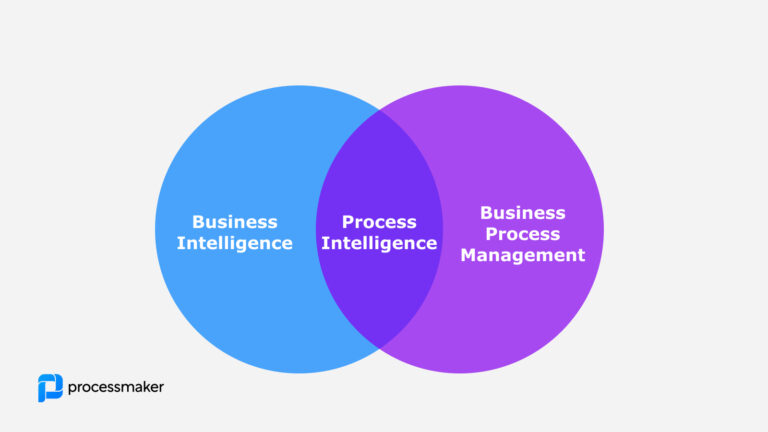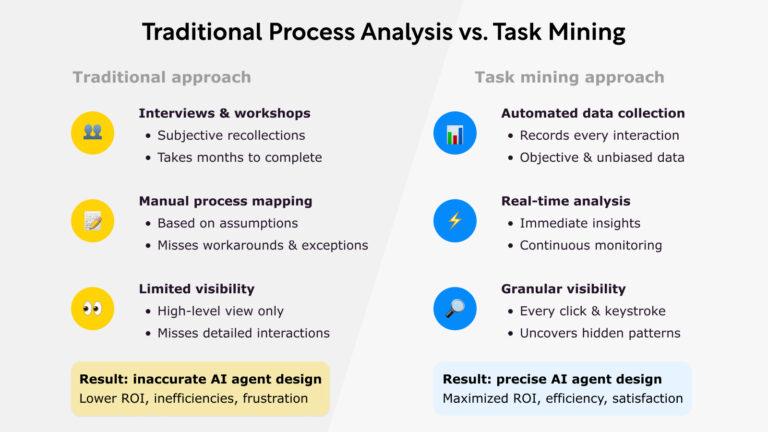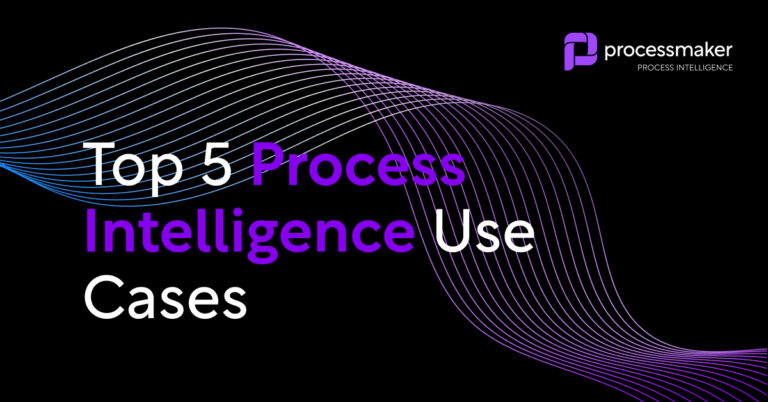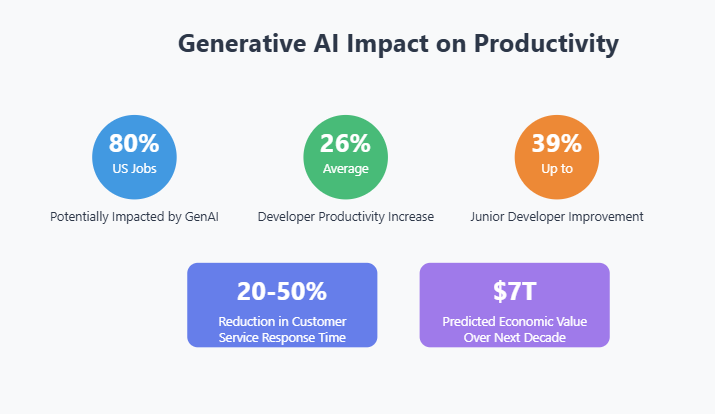Process intelligence is the use of business intelligence strategies and technologies in business process management. Process intelligence can be used to remove bottlenecks or improve operational efficiency, and it can be used as a catalyst for business process re-design.
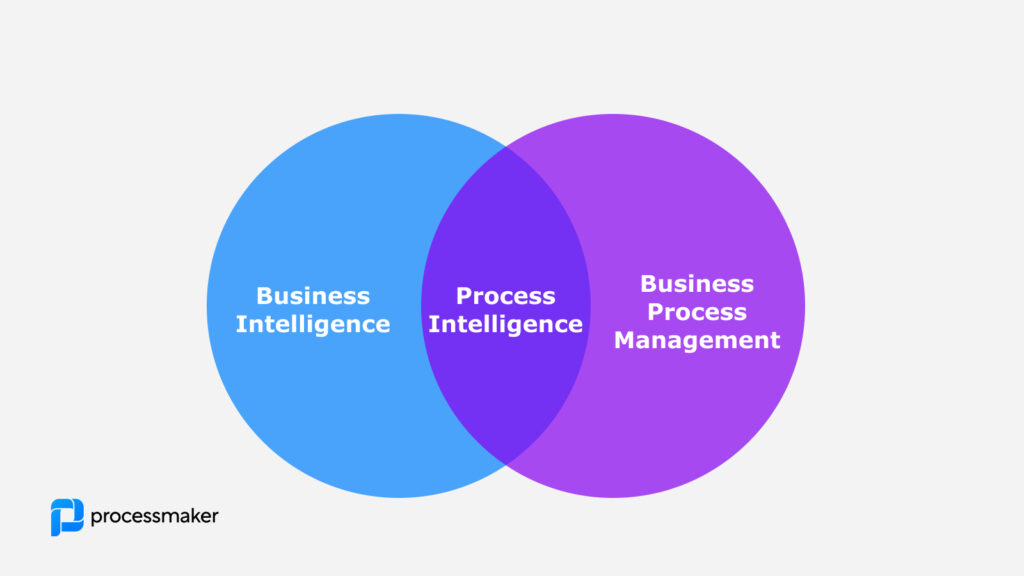
Business process intelligence is a crucial methodology that incorporates business intelligence techniques into business process management. It plays a significant role in identifying bottlenecks and improvement opportunities, ultimately enhancing operational efficiency and informing process redesign.
Process intelligence can be seen as an advanced analytical approach that combines data mining, process modeling, and automation to optimize and enhance business operations by improving process efficiency and visibility. In this way, it goes well beyond the realm of business intelligence to provide sophisticated process insights and automated process analysis capabilities.
Process intelligence software enables organizations to gain deep insights into how their processes function, identify areas of improvement and implement changes that lead to better efficiency and effectiveness. It comes in different forms and is occasionally confused with process mining or business intelligence (BI) software.
Process Intelligence vs. Process Mining
Process intelligence and process mining are two powerful methodologies used by businesses to analyze, optimize, and improve their operations. Although they share some similarities, they have distinct differences in terms of their approach, scope, and capabilities.
Process intelligence is a comprehensive approach to understanding and optimizing business processes by leveraging data and analytics. Process mining is a subset of process intelligence that focuses on analyzing event logs generated by information systems, such as ERP or CRM applications, and includes process mining capabilities to extract actionable insights.
Differences between process intelligence and process mining
- Scope: Process intelligence covers a broader range of processes across an organization, whereas process mining focuses on specific processes that are captured in event logs.
- Data Sources: Process intelligence uses a wider variety of data sources, including structured and unstructured data, while process mining relies primarily on event logs from information systems.
- Approach: Process intelligence takes a more holistic approach to process analysis, encompassing process discovery, monitoring, optimization, and automation. Process mining, on the other hand, primarily focuses on process discovery and analysis.
- Capabilities: Process intelligence offers a wider range of capabilities, such as real-time monitoring, workflow automation, and advanced analytics. Process mining is more specialized, concentrating on the analysis of event logs to uncover process inefficiencies and bottlenecks. Process intelligence tools provide insights into process performance, allowing organizations to identify inefficiencies, streamline operations, and continuously improve metrics that align with strategic goals.
Process intelligence vs. business intelligence
Another common source of confusion is between process intelligence and business intelligence tools such as self-built process analytics.
Business intelligence (BI) is a technology-driven methodology used to analyze data and transform it into actionable insights for informed decision-making. It focuses on providing a comprehensive understanding of an organization’s performance, market trends, and customer behavior.
Differences between process intelligence and business intelligence
- Primary Focus: Process intelligence primarily focuses on the analysis and optimization of business processes, while business intelligence is concerned with providing a holistic view of an organization’s performance, market trends, and customer behavior.
- Scope: Process intelligence typically analyzes processes within an organization, such as supply chain management, customer service, and human resources. Business intelligence covers a broader range of data sources, including financial data, sales data, customer data, and industry data.
- Data Types: Process intelligence mainly deals with operational data related to business processes, including business process data to identify bottlenecks and improve operational efficiency, while business intelligence incorporates a wide variety of data types, such as structured and unstructured data, as well as internal and external data sources.
- Capabilities: Process intelligence offers capabilities like workflow automation, real-time monitoring, and process optimization. Machine learning algorithms are utilized in process intelligence to analyze data, identify patterns, and predict future performance, enabling organizations to automate processes and continuously improve operational results. Business intelligence provides a wider range of analytics capabilities, including descriptive, diagnostic, predictive, and prescriptive analytics.
How Process Intelligence Works
Conceptually you can also think of process intelligence as data that has been systematically collected to analyze by process analysts or subject matter experts, such as operational excellence professionals. This analysis fosters continuous improvement by allowing organizations to monitor performance and make data-driven adjustments over time.
On a high level, you can visualize process intelligence answers three key questions:
Question 1: How process data is collected?
Question 2: What is done with the process data?
Question 3: Why is process intelligence utilized?
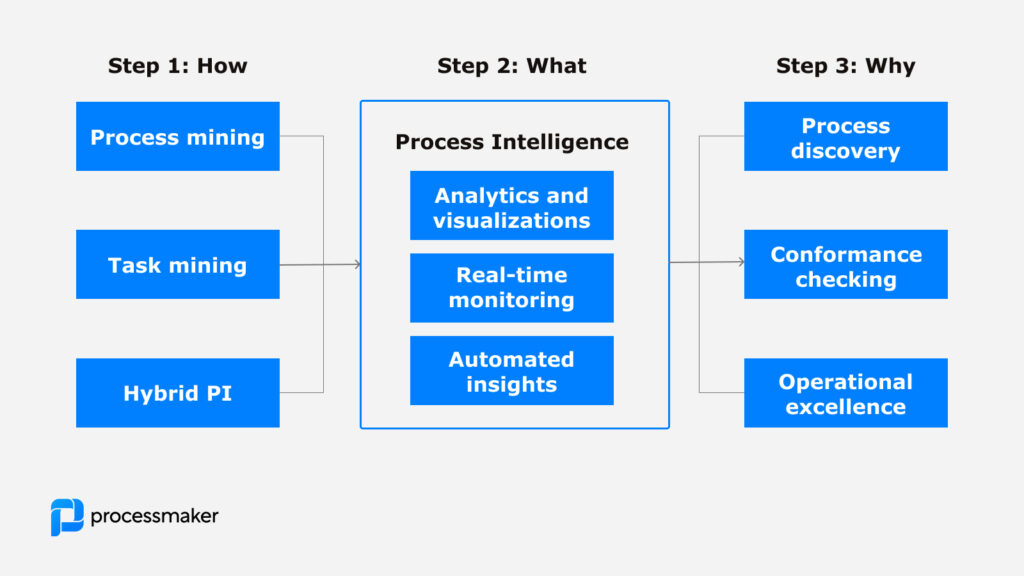
Process improvement is a key outcome of process intelligence analysis, enabling companies to optimize their workflows, identify inefficiencies, and drive continuous process excellence.
How process data is collected?
Process Intelligence begins with collecting data from various sources, such as IT systems, databases, and even employee input. This information is then used to create a comprehensive view of how processes are currently functioning within the organization.
Robotic process automation can be integrated with process intelligence for streamlined data collection and analysis, enabling more efficient decision-making and reducing operational costs.
Method 1: Process Mining
Process mining involves extracting event logs from IT systems and using them to reconstruct process models. This allows organizations to visualize and understand the actual flow of their processes, identify bottlenecks, and uncover opportunities for improvement.
Method 2: Task Mining
Task mining, on the other hand, uses task capture technology to analyze user-generated data, such as mouse clicks, keystrokes, and screen recordings. This helps organizations understand how employees are performing their tasks, identify best practices, and pinpoint areas where additional training or support may be needed.
Method 3: Hybrid approach
The latest method for collecting process intelligence is a hybrid process intelligence method. In essence, this combines elements of both task mining and process mining to provide a faster and less invasive way to collect process data from the user interface or from within business application metadata. See the latest whitepaper for more information.
What is done with process data?
Once the data has been collected, process intelligence tools utilize process mining algorithms to cleanse, harmonize and present the process data in a way that can be analyzed by process analysts. Three key components of process intelligence are:
Analytics and Visualizations
Process intelligence provides advanced visualizations, dashboards and data tables that can be sliced and diced by analysts or exported into other reporting and analytics tools, such as spreadsheets or enterprise BI reporting.
Real-time Monitoring
One of the key advantages of process intelligence compared to manual process analysis is the ability to collect and analyze data in real-time. Process intelligence reports can be updated regularly or some process intelligence tools provide continuous monitoring capabilities as data is collected and utilized across different processes.
Automated Insights
Once the processes have been analyzed and optimized, Process Intelligence can provide automated insights and recommendations. This can range from simple task improvement opportunities to more complex recommendations for end-to-end process execution.
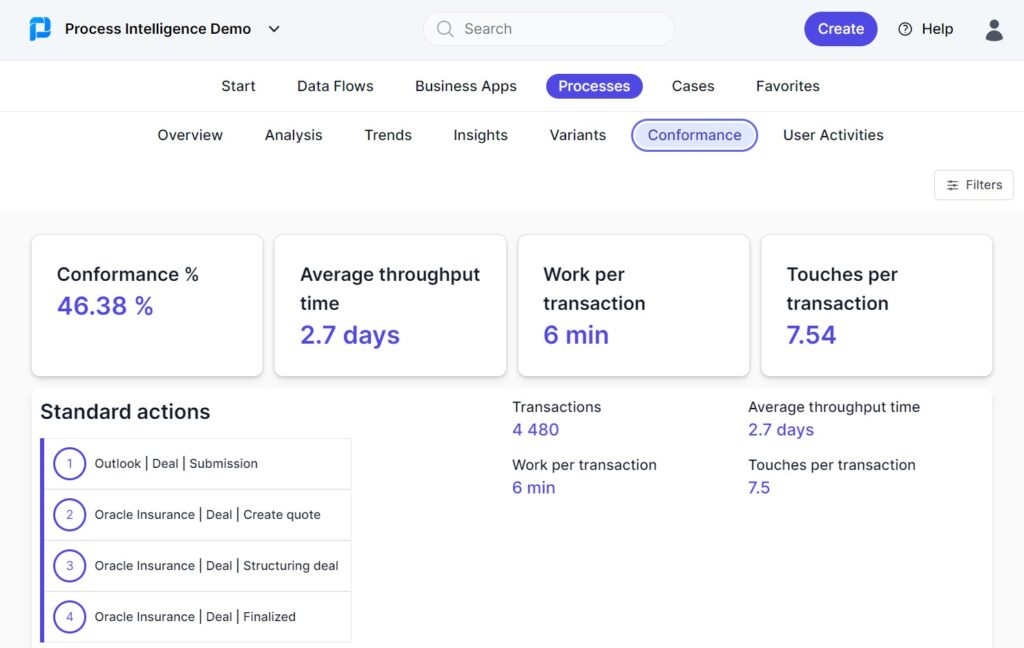
Example of automated process intelligence software – ProcessMaker PI
Why process data is used?
Process intelligence is a powerful tool in the hands of a process analyst or enterprise transformation leader. Some of the key ways it can be used to drive business value are process discovery, conformance checking and driving operational excellence.
Process Discovery
By visualizing the processes through maps and diagrams, Process Intelligence allows organizations to gain a clear understanding of their current state. Process discovery not only helps in identifying inefficiencies and bottlenecks but also facilitates communication and collaboration between different teams and departments.
Conformance Checking
Process intelligence is used to monitor process and workflows against the agreed ideal process model or happy path. This conformance checking can align performance of teams and business units against commonly agreed standard operating procedures.
Driving Operational Excellence
Process metrics are quantitative measures that help organizations track the performance of their processes to drive operational excellence. Examples include cycle times, throughput, error rates, and customer satisfaction scores. These metrics provide valuable insights into the effectiveness of processes and help identify areas for improvement.
Advantages of Process Intelligence
When considering the benefits of process intelligence it’s useful to remember that most businesses still use manual process analysis methods, such as process discovery workshops, process analysis interviews or time and motion studies. Compared to these time and work intensive process analysis methods automated process intelligence offers a number of advantages:
- Enhanced Efficiency. By identifying and eliminating bottlenecks, redundancies, and inefficiencies, Process Intelligence enables organizations to streamline their operations and improve overall productivity.
- Cost Reduction. Process optimization often leads to cost savings through reduced manual effort, lower error rates, and faster process execution times. These cost reductions can have a significant impact on a company’s bottom line.
- Improved Compliance. Process Intelligence helps organizations maintain compliance with industry regulations and internal policies by providing greater visibility into processes and ensuring that any deviations are quickly identified and addressed.
- Increased Agility. With a deeper understanding of their processes, organizations can quickly adapt to changing market conditions, customer demands, and emerging technologies. This agility is crucial for staying ahead of the competition and driving innovation.
Read case-study how one medium-sized business process outsourcing (BPO) firm uncovered over € 2 million ($2.17 million) in process waste within 30 days of implementing process intelligence.
Best Practices Implementing Process Intelligence Tools
Process intelligence is rarely a one-and-done exercise. Success requires consistency, experience and change management. Here are a few best practices to get you on the path to effective implementation.
- Choose the Right Processes. When implementing Process Intelligence, it is essential to focus on the processes that have the most significant impact on the organization’s goals and objectives. This could include customer-facing processes, core operational processes, or support processes.
- Establish Clear Goals. Before embarking on a Process Intelligence initiative, it is crucial to define clear goals and objectives. These could include cost reduction, improved compliance, increased efficiency, or enhanced customer satisfaction.
- Employ the Right Tools. Selecting the right tools and technologies is critical for the success of any Process Intelligence initiative. This may involve investing in process mining software, RPA solutions, or advanced analytics platforms.
- Train Your Team. Ensuring that your team has the necessary skills and knowledge to effectively implement and manage Process Intelligence is essential. This may involve training in process mapping, data analysis, automation tools, or change management.
- Monitor and Optimize. Once Process Intelligence has been implemented, it is vital to continuously monitor performance, identify opportunities for further improvement, and optimize processes accordingly. This ensures that organizations continue to derive maximum value from their Process Intelligence initiatives.
The Bottom Line
Process Intelligence is a powerful approach that enables organizations to optimize their business processes, drive efficiency, reduce costs, and improve compliance. By leveraging data analysis, process visualization, and automation, companies can gain a competitive edge and thrive in today’s fast-paced business environment.
Process Intelligence FAQs:
1. What is the main purpose of Process Intelligence?
The main purpose of Process Intelligence is to optimize and enhance business processes by providing organizations with deep insights into their processes and enabling them to make data-driven decisions.
2. How is Process Intelligence different from Business Process Management (BPM)?
While both Process Intelligence and BPM focus on improving business processes, Process Intelligence emphasizes data-driven insights, analysis, and automation, whereas BPM typically focuses on process design, documentation, and governance.
3. What are some common use cases for Process Intelligence?
Common use cases for Process Intelligence include identifying and eliminating bottlenecks, enhancing efficiency, reducing costs, improving compliance, and increasing agility.
4. Do I need specialized software for Process Intelligence?
While specialized software can be helpful for specific aspects of Process Intelligence, such as process mining or RPA, much of the analysis and optimization can be done using standard data analysis and visualization tools.
5. What is the difference between process intelligence and process mining?
Process intelligence is a comprehensive approach to understanding and optimizing business processes by leveraging data and analytics. Process mining is a subset of process intelligence that focuses on analyzing event logs generated by information systems, such as ERP or CRM applications.
